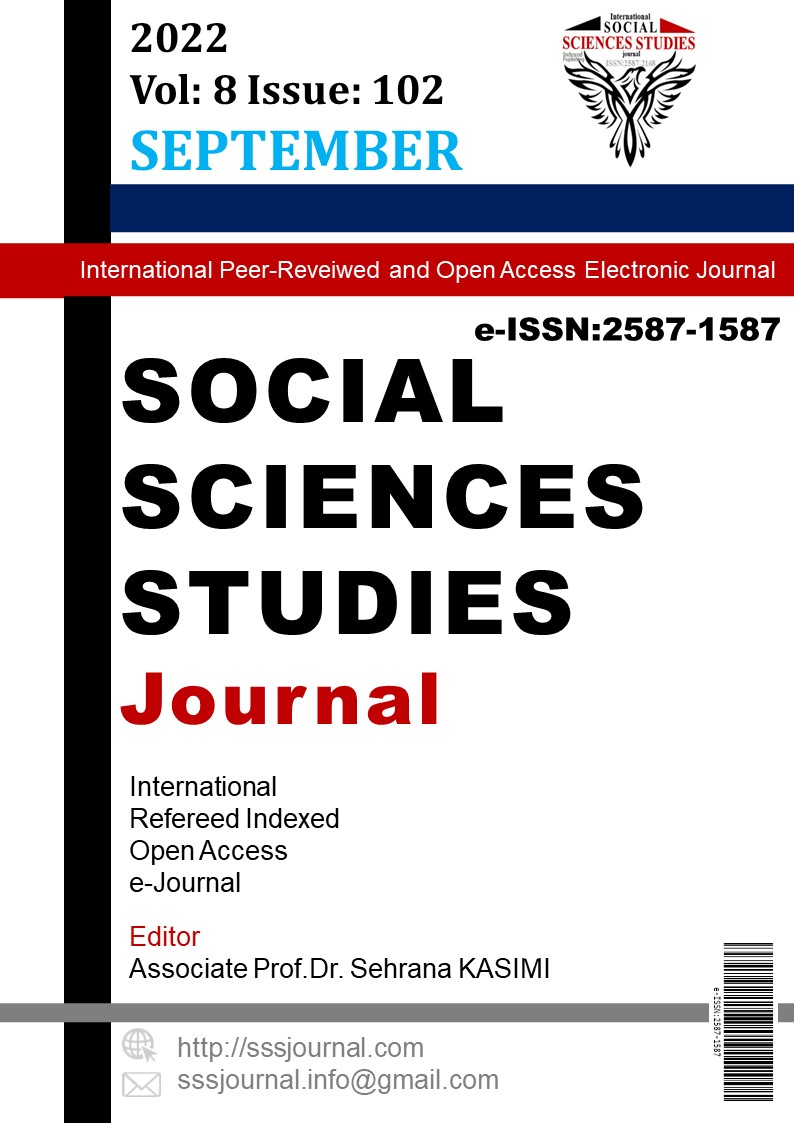Tarım-Gıda Tedarik Zincirinin Sürdürülebilir Scor Performans Değerlendirmesi: Tarım İşletmesi Örneği
Author :
Abstract
Gıda sistemleri doğası gereği doğrusal olmayıp son derece dinamik bir yapıya sahip karmaşık sistemlerdir. Bu çerçevede bir gıda sistemi, gıdanın üretim öncesi, üretimi, işlenmesi, dağıtımı, hazırlanması ve tüketimi ile ilgili tüm unsurları ve ilgili faaliyetleri içermektedir. İklim değişikliği mevcut durumda tarım-gıda tedarik zincirinde gıda güvencesini olumsuz etkilemektedir. Bundan dolayı gıda sisteminin sürdürülebilirliği için tarım sektörünün performansının değerlendirilmesi ve çevresel etkileri iyileştirmeye yönelik kaynak kullanımında daha verimli süreçlerin tasarlanması önemlidir. Tedarik zinciri konseyi tarafından geliştirilen SCOR modeli ile problemlerin kök analizi gerçekleştirilebilmektedir. Bu kapsamda çalışmada Sürdürülebilir SCOR metrikleri ile bir tarım işletmesinin sürdürülebilir kalkınma ilkeleri çerçevesinde tedarik zinciri performansının değerlendirilmesi amaçlanmıştır. Çalışmada uzman görüşleri alınarak belirlenen SCOR metriklerinin AHP yöntemi ile ağırlıkları belirlenmiştir. İkinci aşamada ise bir tarım işletmesinin mevcut performans ölçütlerinin normalizasyonu Snorm De Beer yöntemi ile yapılarak tarım iletmesinin performans düzeyi trafik ışığı yöntemi ile değerlendirilmiştir. Sürdürülebilir SCOR metriklerinin tarım-gıda tedarik zincirine uygulamasının ilk örneğini oluşturan bu çalışma Türkiye’deki tarım-gıda tedarik zincirlerinin performans ölçümünde bir kaynak olması amaçlanmıştır.
Keywords
Abstract
Food systems are not linear in nature, they are complex systems with an extremely dynamic structure. In this framework, a food system includes all elements and related activities related to pre-production, production, processing, distribution, preparation and consumption of food. Climate change currently negatively affects food security in the agri-food supply chain. Therefore, for the sustainability of the food system, it is important to evaluate the performance of the agricultural sector and to design more efficient processes in resource use to improve environmental impacts. Root analysis of problems can be performed with the SCOR model developed by the supply chain council.For this reason, the aim of this study is to evaluate the supply chain performance of an agricultural enterprise within the framework of sustainable development with SustainableSCOR metrics. In this study, the weights of the SCOR metrics determined by taking expert opinions were determined by the AHP method. In the second stage, the normalization of the current performance criteria of an agricultural enterprise was made with the Snorm De Beer method and the performance level of the agricultural enterprise was evaluated by the traffic light method. This study, which constitutes the first example of the application of sustainableSCOR metrics to the agri-food supply chain, is aimed to be a resource in the performance measurement of the agri-food supply chains in Turkey.
Keywords
- 1. Chaiyaphan, C., ve Ransikarbum, K. (2020). Criteria Analysis of Food Safety Using the Analytic Hierarchy Process (AHP)-A Case study of Thailand's Fresh Markets. E3S Web of Conferences, 141, 1–7. https://doi.org/10.1051/e3sconf/202014102001
- 2. APICS. (2017). Supply Chain Operations Reference Model: SCOR Version 12.0. Chicago: APICS.
- 3. Chaiyaphan, C., ve Ransikarbum, K. (2020). Criteria Analysis of Food Safety using the Analytic Hierarchy
- 4. Childerhouse, P., ve Towill, D. (2000). Engineering Supply Chains To Match Customer Requirements. Logistic Information Management, 337-346.
- 5. Chopra, S., Meindl, P. (2007). Supply Chain Management. Strategy, Planning & Operation. In: Boersch C., Elschen R. (eds) Das Summa Summarum des Management. Gabler.
- 6. Espinosa, A. (2011). Complexity Approach to Sustainability: Theory and Application. River Edge-NJ: World Scientific Publishing Co.
- 7. FAO. 2013. Report of the First Meeting of the Plenary Assembly of the Global Soil Partnership (Rome, 11-12 June 2013). Hundred and Forty-eighth session, Rome, 2-6 December 2013, CL 148/13, Rome.
- 8. Gallo, A., Accorsi, R., Baruffaldi, G., & Manzini, R. (2017). Designing Sustainable Cold Chains for Long- Range Food Distribution: Energy-Effective Corridors on the Silk Road Belt. Sustainability, 1-20.
- 10. Luthra S., Garg D., Haleem A. (2014). Critical Success Factors of Green Supply Chain Management for Achieving Sustainability in Indian Automobile Industry. Product Plan Control. http://dx.doi.org/10.1080/09537287.2014.904532
- 11. Mangla S., Madaan J., Sarma P.R.S., Gupta M.P. (2014). Multi-Objective Decision Modelling Usinginterpretive Structural Modelling For Green Supply Chains. International Journal of Logistics System Management 125–142.
- 12. Moreira, L. L., de Brito, M. M., & Kobiyama, M. (2021). Effects of Different Normalization, Aggregation and Classification Methods on The Construction of Flood Vulnerability Indexes. Water (Switzerland), 13(1). https://doi.org/10.3390/w13010098
- 13. Neely, A., Gregory, M., ve Platts, K. (1995). Performance Measurement Systems Design: A Literature Review and Research Agenda. International Journal of Operations and Production Management, 80-116.
- 14. Parmigiani A., Klassen R.D., Russo M.V. (2011). Efficiency Meets Accountability: Performance Implications of Supply Chain Configuration, Control and Capabilities. Journal of Operation Management. 212–223.
- 15. Peattie, K. (1999). Trapping Versus Sunstance in the Greening of Marketing Plan. Journal of Strategic Marketing, Vol:7, 131-148.
- 16. Prasetyaningsih, E., Muhamad, C. R., & Amolina, S. (2020). Assessing of Supply Chain Performance by Adopting Supply Chain Operation Reference (SCOR) model. IOP Conference Series: Materials Science and Engineering, 830(3). https://doi.org/10.1088/1757-899X/830/3/032083
- 17. Pulansari, F., & Putri, A. (2020). Green Supply Chain Operation Reference (Green SCOR) Performance Evaluation (Case Study: Steel Company). Journal of Physics: Conference Series, 1569(3). https://doi.org/10.1088/1742-6596/1569/3/032006
- 18. Srivastava S.K. (2007) Green Supply-Chain Management: A State of the Art Literature Review. International Journal of Management. 53–80.
- 19. Stephens, S. (2001). Supply Chain Operations Reference Model Version 5.0: A New Tool to İmprove Supply Chain Efficiency and Achieve Best Practice. Information Systems Frontiers, 471- 476.
- 20. Tan, K. C., Lyman, S. B., & Wisner, J. D. (2002). Supply Chain Management: A Strategic Perspective. International Journal Of Operations & Production Management.
- 21. Zachariah, B., Ayuba, P., & Damuut, L. P. (2017). Optimization of Traffic Light Control System of an Intersection Using Fuzzy Inference System. Science World Journal, 12(4), 27–33.
- 22. Zhu Q., Sarkis J., Geng Y. (2005) Green Supply Chain Management in China: Pressures, Practices and Performance. International Journal of Operations and Production Management. 449–68.
- 23. Zhu Q, Tian Y, Sarkis J. (2012). Diffusion of Selected Green Supply Chain Management Practices: An Assessment of Chinese Enterprises. Production Plannig and Control: The Management of Operations. 837– 850. https://doi.org/10.1080/09537287.2011.642188
- 24. URL-1, https://en.wikipedia.org/wiki/Sustainable_Development_Goals Erişim Tarihi: 28 Mayıs 2022.
